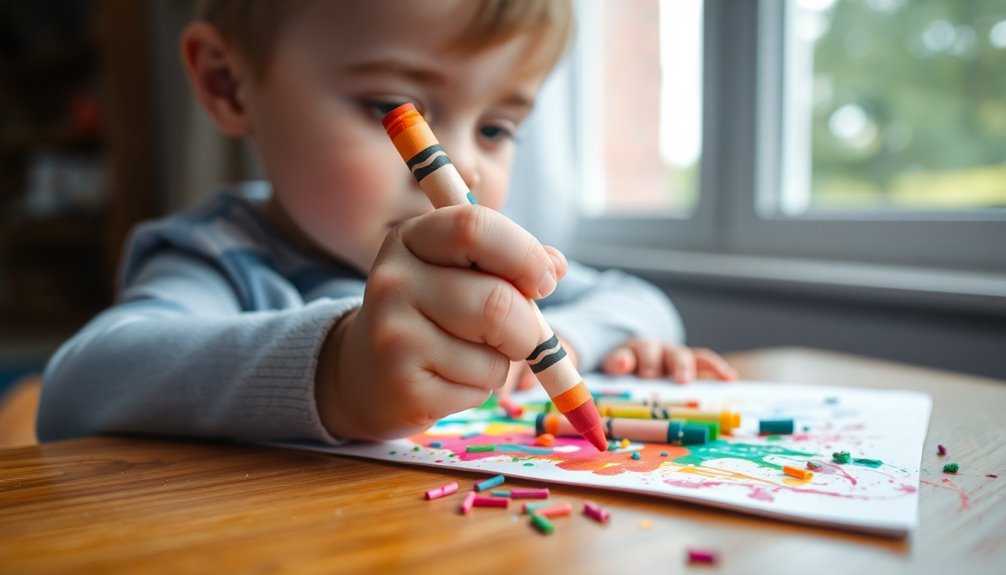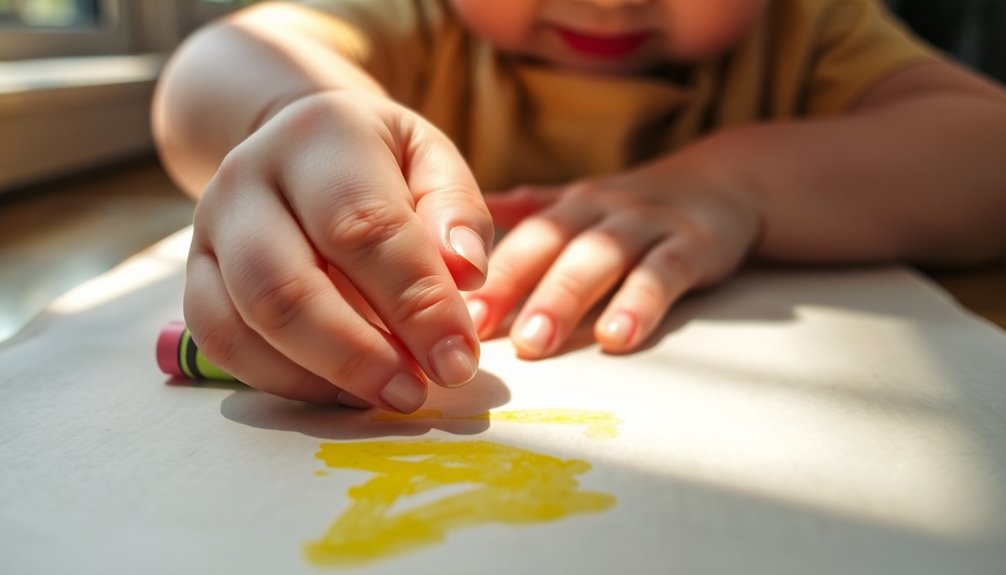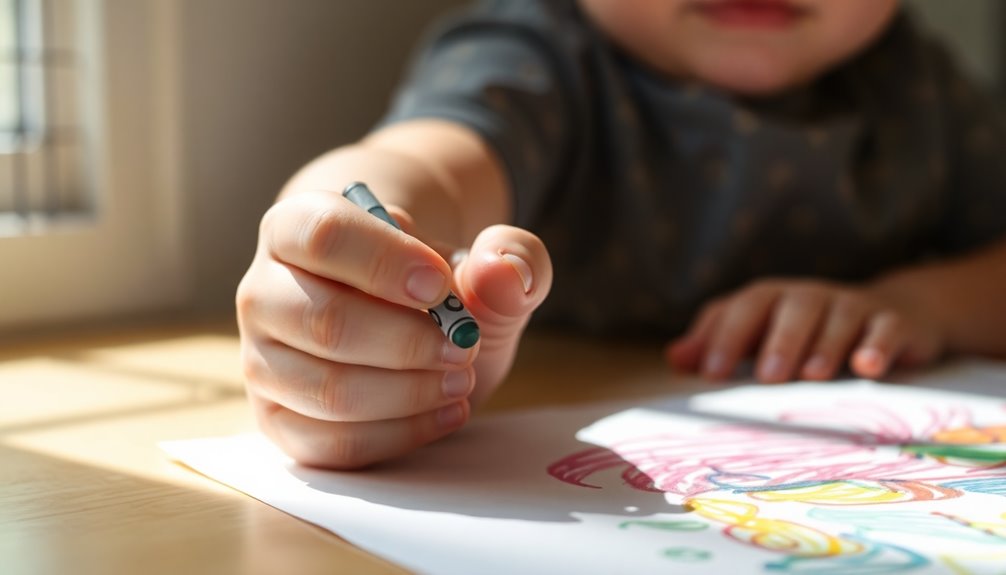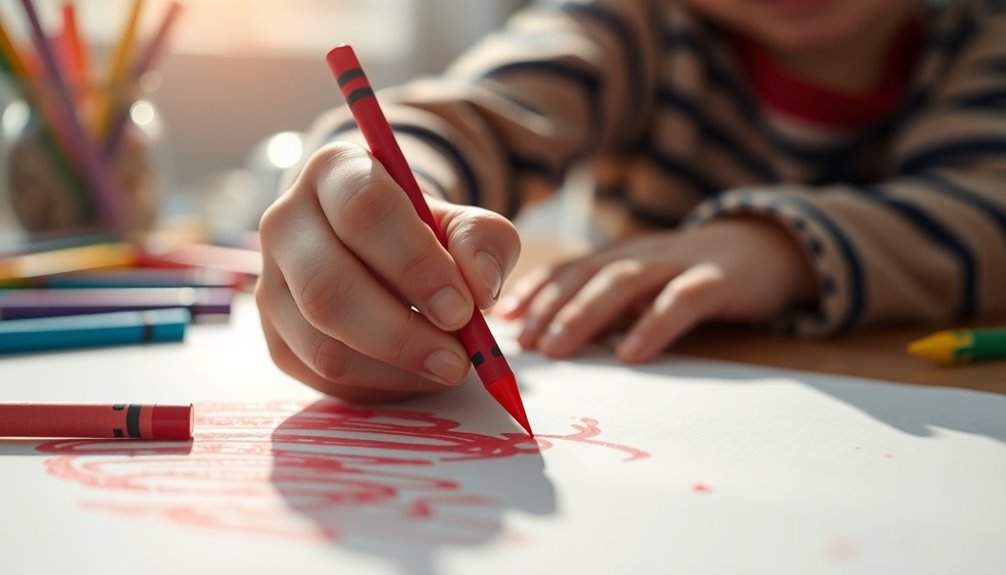If you're wondering whether your child might be left-handed, watch for signs like consistent left hand use when reaching for toys or eating. By ages 2-3, you might notice improved fine motor skills centered around their left hand. Kids typically establish clear handedness by age 5-6. Pay close attention to activities like coloring or playing, as these can reveal their natural preference. Keep exploring to uncover more tips and insights on supporting left-handed children.
Key Takeaways
- Signs of left-handedness typically appear around 18 months, with consistent reaching for objects using the left hand.
- By ages 2-3, observe improved fine motor skills indicating a developing hand preference.
- Look for consistent use of the left hand during activities like coloring, eating, or playing with toys.
- Full establishment of handedness usually occurs between ages 5-6, when a child's dominant hand becomes clear.
- Support left-handed children with appropriate tools like left-handed scissors and utensils to aid their development.
Signs Your Baby Might Be Left-Handed

As you watch your baby grow, you might notice signs of left-handedness emerging around 18 months. Your child may consistently reach for objects with their left hand, hinting at a developing hand preference.
By ages 2-3, as fine-motor skills improve, you might see your little one start to show hand dominance, although some still experiment with both hands. Activities like eating with a spoon or coloring with the left hand can further indicate a preference for left-handedness. Additionally, engaging in activities that require mental challenges can help develop your child's cognitive skills. Furthermore, it's important to recognize that nutritional benefits such as omega-3 fatty acids can play a role in overall brain development, as they are known to aid in fat metabolism.
While full establishment of handedness typically occurs between ages 5-6, these early signs can help you identify a left-handed child early on. Additionally, understanding emotional dysregulation can be beneficial in recognizing how your child's temperament may influence their development.
The Development of Hand Dominance in Children

Understanding how hand dominance develops in children is essential for recognizing their natural preferences. Typically, handedness starts to emerge between 18 months and 4 years.
During these years, some young children may show a clear dominant hand while others use both hands equally, often remaining ambidextrous until ages 5-6. You might notice which hand your child favors during activities like eating or coloring, as consistent use can indicate their dominant hand. Moreover, nutrition plays a crucial role in overall brain development during this period, which may also influence hand preference. A well-balanced diet that includes omega-3 fatty acids can particularly support cognitive function and help in the development of hand dominance. Engaging in activities with educational toys can also encourage fine motor skills that contribute to hand preference development.
Genetics can influence this development, with studies suggesting that prenatal thumb-sucking may play a role. Additionally, emotional well-being during early childhood can impact a child's overall development, including their preferences for hand dominance.
Observational Tips for Identifying Hand Preference

When observing a child to identify their hand preference, pay attention to their natural tendencies during everyday activities. Look for consistent use of one hand over the other, especially in tasks like holding a crayon, eating, or playing. By age five or six, a child's dominant hand usually becomes clear, as this is a crucial period for motor skill development.
| Activity | Left Hand Use | Right Hand Use |
|---|---|---|
| Hold a Crayon | Often chooses left hand | Often chooses right hand |
| Throw a Ball | Accuracy with left hand | Accuracy with right hand |
| Cutting | Prefers left hand | Prefers right hand |
| Stirring Liquids | Uses left hand | Uses right hand |
These observations can reveal their hand preference and help you understand their natural inclinations. Additionally, supporting their development with educational toys can enhance their cognitive and motor skills during these formative years.
Supporting Left-Handed Children in a Right-Handed World

Identifying a child's hand preference is just the beginning; supporting left-handed children in a primarily right-handed world is equally important.
As you observe the hand they use, remember that many left-handed children struggle with right-handed tools. It's a good idea to provide them with left-handed scissors and writing instruments to help your child develop their skills comfortably.
Encourage them to explore their handedness without pressure, as their dominant hand typically solidifies between ages 3 and 6.
Communicating with teachers and caregivers about your child's left-handedness guarantees they receive necessary support.
Celebrating Left-Handedness: Tools and Resources

While steering through a world designed for right-handers, it's essential to celebrate left-handedness by providing the right tools and resources.
Left-handed scissors can boost crafting confidence, allowing your child to participate in activities without frustration. Opt for left-handed notebooks with bindings on the right side; this helps prevent smudging while they write comfortably.
Utilizing left-handed utensils, like Kizingo curved spoons, promotes independence during meals. Encourage the use of left-handed pens to improve grip and reduce ink smudging for a smoother writing experience.
Celebrating left-handedness through specially designed gifts enhances your child's self-esteem and reinforces their identity, helping them navigate a mainly right-handed world with pride.
Frequently Asked Questions
How to Determine if a Child Is Left-Handed?
To determine if a child is left-handed, watch for signs starting around 18 months.
Notice if they consistently reach for objects with their left hand or prefer using it for activities like eating, drawing, or throwing a ball by ages 2-3.
Observe their fine motor skills, like holding crayons or using scissors.
If they seem more comfortable using their left hand, they might be developing left-handed dominance.
Just keep an eye on their interactions!
What Month Is Most Likely to Be Left-Handed?
You might wonder if children born in certain months are more likely to be left-handed. For instance, if you have a friend whose child, born in July, seems to favor their left hand, you could start questioning the month's influence.
However, research shows that handedness isn't tied to birth months. It's mostly genetic and environmental.
Only about 10% of kids are left-handed, regardless of when they're born, so keep that in mind!
At Which Age Is Handedness Usually Evident?
Handedness usually becomes evident around 18 months, with signs of preference appearing more clearly between ages 2 and 3.
By ages 3 to 6, most children solidify their hand dominance, with full establishment often occurring by age 5 or 6.
As you watch your child, pay attention to which hand they consistently use during activities like eating, coloring, or playing. This can help you identify their developing handedness.
How to Test for Left-Handedness?
To test for left-handedness, watch how your child uses their hands during everyday activities.
Notice which hand they prefer while eating, coloring, or writing. You can also engage them in tasks like throwing a ball or stirring a bowl—left-handed kids often excel with their left hand.
Don't rush the process; let them explore both hands freely, as their dominant hand usually becomes clear around ages 3 to 6.
Conclusion
Now that you know how to spot signs of left-handedness in your child, you can better support their unique journey. Understanding hand dominance is essential, especially in a world designed for right-handers. Why not celebrate their individuality and help them thrive? By recognizing their needs and providing the right tools, you can empower your left-handed child to embrace their strengths. After all, every child deserves to shine, no matter which hand they prefer!









